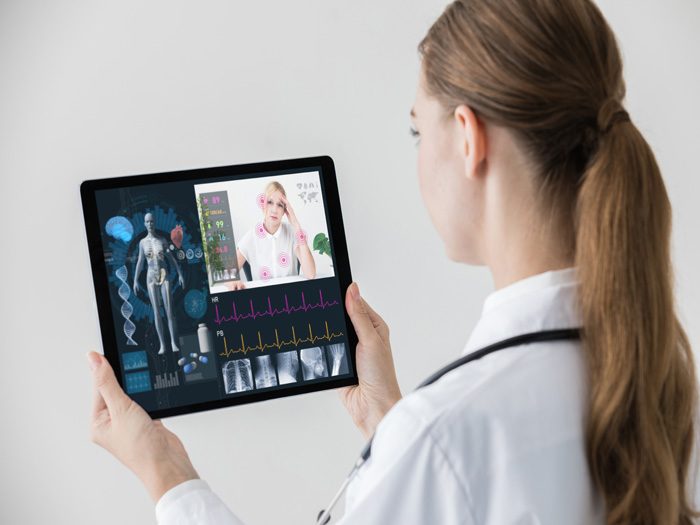The Benefits of Telemedicine
Is Telemedicine Actually Impacting Your Workers’ Comp Claims?

The idea of receiving precision health care from the comfort of one’s home has only grown since the inception of telemedicine. Though still not widely adopted by the general public, telehealth is making up ground in becoming a viable option for some patients and providers.
It’s also becoming a more viable option in the workers’ compensation industry, despite regulatory obstacles.
And while telemedicine has become something of a ‘buzzword’ in workers’ comp, many industry professionals are seeing that this practice produces positive results.
Over 550 workers’ comp professionals were surveyed for a Mitchell International Inc. study on telemedicine perception. The results showed that 45 percent of respondents see promise in telemedicine when it comes to cutting costs and impacting the industry. In fact, the U.S. telemedicine market is slated to grow at an annual rate of six percent over the next few years, likely to reach nearly $7 billion in value by 2020.
So exactly how is telemedicine impacting your workers’ comp claims?
More Physicians Are Available
Fewer health care practices are accepting workers’ compensation cases due to the continuously changing health care insurance climates and the pressures a workers’ comp patient might impose. This impacts workers’ comp firsthand as employers attempt to find treating physicians who will work with their needs. Telemedicine acts as a solution.
“The beauty of telemedicine is if a clinician is licensed in the state — they can practice in that whole state and provide care where there may not be any center even open at that time,” said Ann Schnure, vice president of telemed operations, Concentra Telemedicine, and a speaker at the upcoming 2018 National Workers’ Compensation and Disability Conference held Dec. 4 through 7 at the Mandalay Bay in Las Vegas.
While telemedicine has become something of a ‘buzzword’ in workers’ comp, many industry professionals are seeing that this practice holds positive results.
This technology has made it possible for injured workers to be assessed almost immediately after injury. Of course, catastrophic cases and other serious injuries need to be treated hands-on, but minor injuries can easily be diagnosed via video chat and conferencing with a certified physician.
This is a great tool to have in rural areas where the nearest health care facility is miles away. It’s also effective in places where the available physicians specialize in areas outside of the injuries suffered (an example: a burn victim in need of a burns specialist three towns over). Telemedicine taps into the physician network, allowing access to broader health care options.
Removing Transportation Struggles
Transportation is a multi-layer problem, said Schnure.
“It’s not just the cost of transportation but the costs of management around that transportation.”
Some workers might not have any means of transport for starters. Others may take taxis and have the receipts reimbursed. Some carriers and care managers have teamed up with ride-share
companies like Lyft to get workers to their appointments, while others have nurse case managers coordinate drivers for the injured workers. But all these transportation costs add up.
“If you have someone who needs transportation on every visit, and say it’s a 20-mile drive around 50 cents per mile — that’s only about $10. But times that by five for multiple appointments, you’re at $50. Now say you have a thousand cases like that; it starts to add up.”
Telemedicine, however, eliminates the need for transportation altogether and encourages injured workers to seek guidance from their providers without leaving home. Check-ups and consultations can happen within minutes using video chat and a telecommunication device, like a smartphone or tablet.
Fewer Missed Appointments
On the other hand, injured workers who can transport themselves to and from their physicians’ offices might find themselves facing time issues. Appointments at a traditional doctor’s office typically coincide with work hours, leaving an injured worker to take paid time off or schedule an appointment before or after work. Taking off work and battling city traffic is not an easy decision for some.
“It’s the number one reason why patients stop following up,” Schnure said. “When they start feeling better, they will skip appointments.”
And missed appointments lead to longer claims.
“A missed appointment can leave a case open,” said Schnure. “An open case has an opportunity for a person to be in a gray area” if their work restrictions expire and they did not continue with their care. Because if this happens, she explained, it’s up to the employer to decide if the worker can return to their job. If it’s too early in the healing process, the worker might face reinjury and a lengthened claim.
With telemedicine, however, a worker can check in at any time.
“It’s what one of our clients coined as ‘stay-at-work-visits,’ ” added Schnure.
Telemedicine Cuts Overall Costs
Researchers at Community Health Center and the University of Connecticut Health Center found that a telemedicine consult platform specific to cardiology cases saved almost $500 per patient in Medicaid costs over in-person treatments. While this is specific to cardiology, it’s a good indicator that telemedicine is cutting costs across the board.
In workers’ compensation, telemedicine can eliminate the need for emergency room visits (and their expensive bills), cut down on transportation expenditure, provide crisis intervention due to on-the-spot care and more.
Christine Williams, managing director, Worker’s Compensation Center of Excellence, U.S. Casualty Practice, Marsh, wrote in an article that telemedicine “could be the difference between good and bad claims outcomes.”
Williams cited having that instant access to a nurse or doctor as a primary reason telemedicine works to cut costs and get injured workers what they need. This fast-paced, instant ability to connect with a medical professional enables the claim to start out right. Just as quickly as the injury occurs, the worker can be assessed and prescribed the proper care.
“[Telemedicine] is another tool in the workers’ comp toolbox,” said Schnure. “The right injury gets directed to the right level of care. It reduces case duration and engages the employee in their return to work.” &











